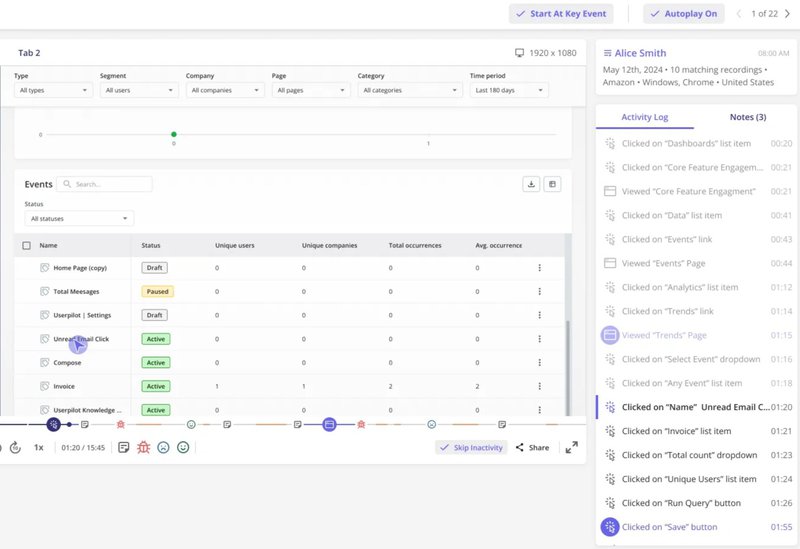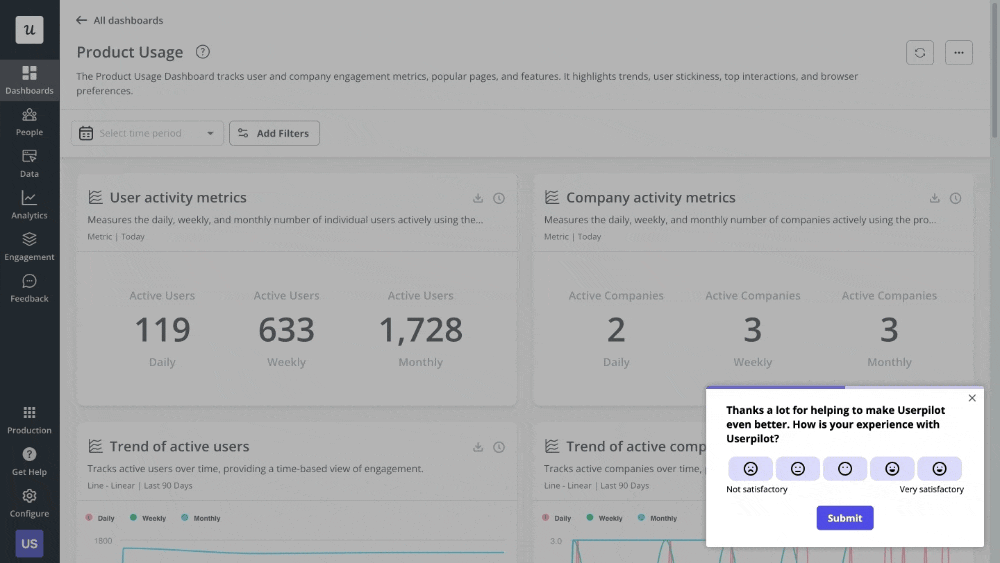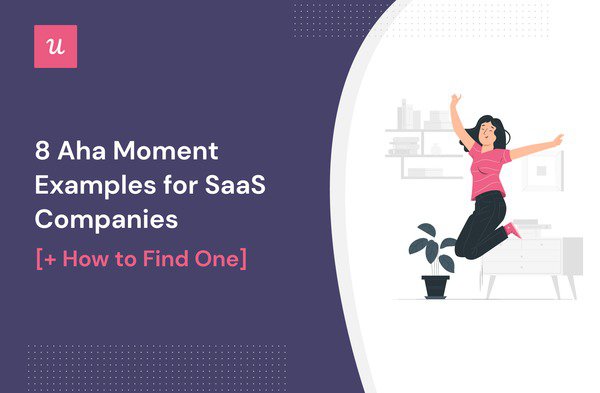
Product managers recognize an ‘Aha moment’ when it comes along in the user onboarding process and acknowledge the enormous value they bring.
In this article, we’ll break down exactly what Aha moments are, why they matter, explore several different types of Aha moment examples, and more.
Ready to make a start?
Let’s get going!
What’s your primary goal with finding Aha Moments?
How do you currently guide users to their “Aha Moment”?
What’s the biggest challenge in identifying your product’s Aha Moment?
Ready to create your product’s Aha Moment?
You’ve got the concepts down. Now, let’s see how Userpilot can help you uncover your product’s unique Aha Moments and guide users to value, faster. See a live demo tailored to your needs.
Try Userpilot Now
See Why 1,000+ Teams Choose Userpilot

What is the Aha moment?
A product’s Aha moment is when a user realizes value in the product – or alternatively, sees enough so they’re convinced that it will be a solution for a specific problem they have.
In the context of product-led growth, the Aha moment acts as the tipping point for user activation. It is an emotional reaction-a feeling of relief or excitement-caused by a specific action inside the product. It’s the realization that “Yes, this tool can actually solve my problem.” Given that, as a product manager, you should be thinking about how to deliver value pretty much every time a customer interacts with your product.
Typically, the primary aha moment happens during the user onboarding process. However, products can also have secondary aha moments throughout the customer journey.
Why does a product’s Aha moment matter?
You’ve got lots of competing priorities. Why should crafting Aha moments be at the top of your to-do list? Here are a few reasons:
- Reduce time to value: Every Aha moment example you introduce in your SaaS should reduce the time to value of your product. Your product’s Aha moment should be a clear demonstration of what the point of your product is. The clearer the demonstration of value, the simpler the activation journey and the greater your chance of driving adoption.
- Increase customer loyalty and retention: When people realize your product’s value, they’ll be more likely to be retained and become power users. Why does that matter? Because retained customers spread positive word of mouth, encouraging new customers to sign up.
- Boost revenue: Retained customers who experience value consistently – i.e., achieve customer success – are also receptive to upsell messages because you’ve got a proven track record of delivering value. This will, in turn, increase your expansion revenue.
8 Aha moment examples from SaaS companies
Next up, we’re going to look at Aha moments from a variety of different SaaS organizations.
1. Slack
About the company: Slack is a messaging app for businesses that “connects people to the information they need.” They offer a range of plugins and tools and serve SaaS businesses of all shapes and sizes.
Aha moment: Slack’s Aha moment is when a team sends 2,000 messages into a workspace. Slack team discovered that this is the point where users realize the value of Slack as a searchable institutional memory.
How they guide new users: Slack leverages user flows in their onboarding process to help new customers get to grips with their functionality fast. They use an interactive walkthrough, which is extremely effective at showing users how to unlock value from the product’s key features.

2. Calendly
About the company: Calendly is a scheduling tool used by teams to schedule, prepare, and follow up on external meetings.
Aha moment: The product’s Aha moment is when users sign in with Google. When a user connects their calendar, it simplifies the usually painful process of going back and forth looking for slots. Giving users the option to practice by booking a meeting with themselves is a masterstroke: it reduces any pressure.
How they guide users. After signing up, Calendly nudges users toward key bits of functionality, organizing the onboarding with an engaging checklist.

3. Demio
About the company: Demio is a cloud-based solution designed to help businesses create, launch, and manage webinars.
Aha moment? This occurs when users participate in a demo webinar, complete with a mock audience. After a brief introduction, you take the reins, practice sharing your material, and engage with the fake crowd.
How do they guide users? Demio’s innovative user onboarding, giving you real-life examples of how the tool is used in practice, creates a far more engaged user base than just telling people about features.

4. Canva
About the company: Canva is an online design and visual communication platform to help users explore and experiment with a range of design tools.
Aha moment? When a user without a design background can quickly produce a polished, professional design (whether that’s a social media graphic, a presentation, or a flyer) in just a few minutes.
How do they guide users? Canva’s onboarding process is key. A welcome survey makes it easy to gather product data that ensures customers get a personalized experience. Showing recommended templates relevant to their roles helps reduce the learning curve.

5. Zoom
About the company: Zoom is a communications platform that enables users to connect with video, audio, phone, and chat.
Aha moment? Zoom’s core value proposition is simplicity. When you are able to set up, organize, and launch a video meeting with very little friction, you realize value from the product experience in your first sessions.
How do they guide users? Zoom guides users toward their Aha moment by making sign-up as simple as possible, reducing barriers to organizing your first meeting.

6. Mailchimp
About the company: Mailchimp is an email marketing platform that helps you reach your audience, optimize conversion rates, and grow your business.
Aha moment? Mailchimp’s Aha moment arrives as soon as the first time users create and send an email. With a drag-and-drop creator and easy target list setiup, the tool completely transforms what might previously have been an arduous journey.
How do they guide users? The onboarding process provides helpful prompts and hints with personalized templates aligned to deliver the most value based on user needs.

7. G2
About the company: G2 is a review platform comparing a whole host of business software and services based on user ratings and social data.
Aha moment? As soon as a user review lands, SaaS companies realize the benefit of having a public-facing review profile. Word of mouth is important: reviews are valuable social proof. You can use your profile as an important testimonial across marketing campaigns.
How do they guide users? G2 encourages users to add as much information as possible to their profile, which makes reaching the Aha moment much more likely.

8. Expensify
About the company: Expensify is a tool that automates expense management, receipt tracking, and the overall business expense process.
Aha moment? When you create an expense report, it takes you significantly less time than other software (reportedly 75%), it’s approved, and you’re reimbursed.
How do they guide users? When you first land on the Expensify website, you can choose exactly which service you’re interested in. The user onboarding flow is designed to ensure a user activates as quickly as possible (i.e., getting a payment approved).

9. Grammarly
About the company: Grammarly is an AI writing assistant. It offers personalized AI guidance and text generation, helping to write smoother, mistake-free texts.
Aha moment: When you install the Grammarly browser extension, you’re presented with a mistake-filled demo text riddled with mistakes. Using the tool to correct them, you realize the tool’s value in quickly correcting any writing.
How do they guide users: The interactive demo is a great example of hands-on onboarding. This simple tool is so intuitive to use that it’s best to learn by actually working with it.

10. Userpilot
About the company: Userpilot is an all-in-one product growth platform. We help product teams deliver personalized in-app experiences to increase growth metrics at every stage of the user journey, and immediately act on product data.
Aha moment: At Userpilot, our data shows the aha moment is tied to publishing the first flow. When the user creates a tooltip or modal with the Chrome Extension and sees it appear on their app without asking a developer for help, they immediately grasp the value: speed, autonomy, and empowerment.
How do they guide users: At Userpilot, we place huge value on personalized, interactive in-app onboarding. With modals, tooltips, and slideouts, we take our users through the shortest possible path to experience our product’s aha moment. We also keep an onboarding checklist active to showcase the steps leading to activation, which helps users stay engaged.

11. Stripo
About the company: Stripo is an email template builder that lets its users create professional emails with no HTML skills and automate email production.
Aha moment: Stripo lets its new users experience the aha moment before they even sign up. On their homepage, they include a CTA to “Try a demo editor,” where prospects can build an email themselves and get a taste of just how effortless sending an email with Stripo is.
How they guide users: The demo editor cleverly educates the user on different Stripo functionalities by describing and showcasing them in the example email body. There are also tooltips that appear after you hover over the button that explain different features.

12. Loom
About the company: Loom is a video messaging platform that revolutionized business communication. It helps all teams win back time and complete projects faster, with AI-powered video messages and meeting notes.
Aha moment: Loom’s value is asynchronous efficiency. The loop isn’t closed until the recipient engages, validating that this new mode of communication effectively replaced a synchronous call or a long email. The aha moment triggers when you share that link, and someone watches it. The realization isn’t “I made a video,” it is “I just saved myself a 30-minute meeting.”
How they guide users: Upon registration, Loom showcases a quick welcome survey that helps determine the user’s use case. Based on the answers, it shows a quick tutorial with modal and tooltips to guide users through their onboarding process and straight to an Aha moment.

How to find your product’s own Aha moment?
We’ve reached a critical stage: you want to surface the Aha moment in your own product. Drawing inspiration from the Aha moment examples above, let’s break down the key steps in the process and how you can maximize value.
Step 1: Collect customer data from multiple sources
First up, you need to orient yourself: you can’t rely on hunches or guesswork. Product analytics is a powerful tool that’ll help you assess user behavior and figure out where in the journey Aha moments (or potential Aha moments) lie.
Gather data from as many users across the whole customer lifecycle or funnel. Remember, you need to look at both churned users and retained customers to build a complete picture.
Here’s where to start:
Map the power user’s behavior
Analyze your power users: those who use the product daily and pay on time. You want to identify what they did in their first 7 days that churned users did not, and create a successful customer journey map.
Use trend analysis reports and path analysis to visualize this data over time. You are looking for a correlation between specific events triggered in the first few sessions and long-term retention (e.g., retention at Day 90).
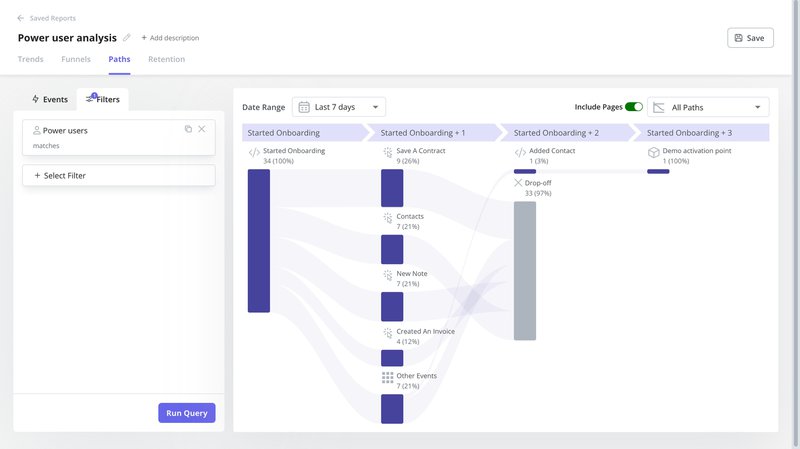
Ask yourself:
- Did they invite a teammate?
- Did they use a specific feature X times?
- Did they integrate with a third-party tool?
If “Action X” correlates with a 95% retention rate, Action X is your strong aha candidate.
Ensure continuous data collection and trend monitoring: paths of power users may change over time.
Analyze how churned users use the product
Once you know your product’s strong points, it’s time to learn the weak ones.
Use funnel analysis to see where drop-offs occur for non-power users versus the happy path of your most successful customers. Try to map out the areas of friction. You will get an overview of what’s stopping your users from finding aha moments in the crucial first days.
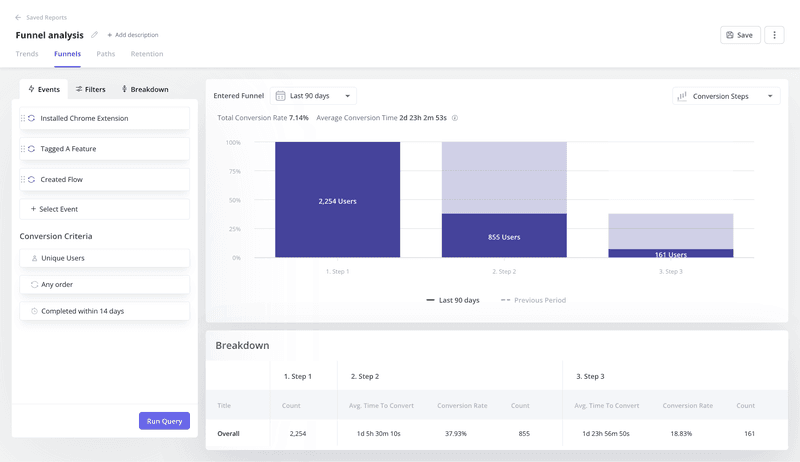
Watch session replays to get even more insights on the drop-off points: you’ll know exactly what causes your users’ struggles.
Conduct interviews to gather more insights
Conducting interviews is costly: both in terms of time spent gathering participants, potentially travelling, and actual cost (sourcing and incentivizing participants, paying for user research expertise).
But if you want in-depth, granular information about specific points when users experience value (i.e., the product’s Aha moments), this form of user research can be worthwhile. It’s particularly helpful for UX design.
Power users are usually the best to gather user feedback from: they’ve got the deepest understanding of your tool (i.e., quirks of the UX design, where each turning point in a journey causes frustration or delight, and more).
Step 2: Define multiple Aha moments
You’ve gathered all your data and started to make sense of it.
Next up, it’s a collaborative effort between product, marketing, and customer success teams to identify multiple Aha moments throughout your app. That breadth of expertise can help you understand the range of user experiences. Different segments will experience different Aha moments based on their distinct needs.
At this stage, you’ll have a list of potential Aha moments across the whole customer journey. But you don’t know for certain which will create the most value.
Step 3: A/B test the onboarding flow with the Aha moment
That’s where a mindset of experimentation comes in handy. User testing is a tool to ruthlessly scrutinize if a hypothesis is correct. For example, you might want to compare a couple of onboarding flows (inspire yourself with the aha moment examples to build them) and see which drives a larger impact.
Let’s work through an example.
Hypothesis: Your tool’s Aha moment is when users interact with a given feature.
Experiment: Run an A/B test comparing a control group with a treatment group that sees a driven action driving the adoption of that feature.
Outcome: Monitor various metrics to gather evidence enabling you to prove or disprove your hypothesis and find the most frictionless onboarding process (i.e., show more relevant content to first-time users and something else to other customers).
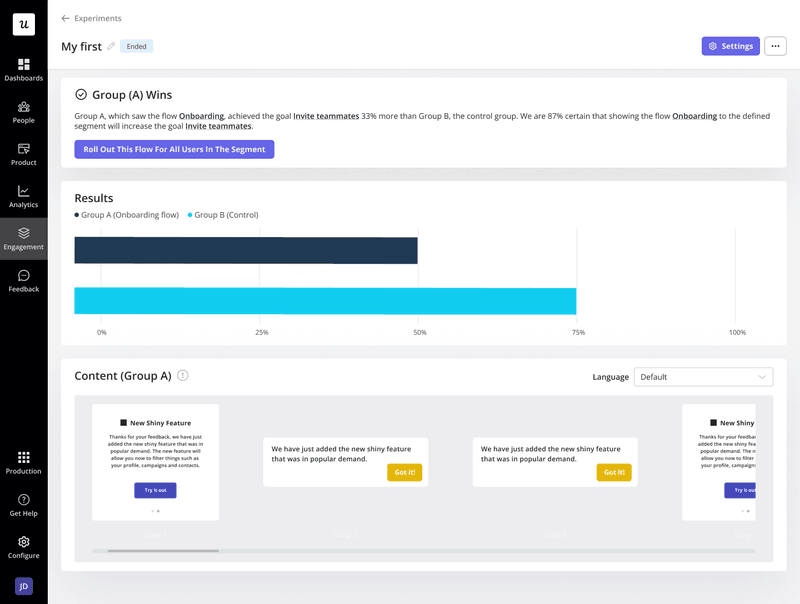
How to guide new and existing users toward Aha moments?
You can’t just create an Aha moment without thinking about how to guide new users toward it. It’s like baking a cake nobody will ever eat!
In the final section of this article, we’ll cover some useful techniques and prepare you to create Aha moments in your SaaS business.
Create personalized user onboarding experiences
Remember that different segments will experience different Aha moments.
Personalization has been proven to boost engagement. For example, you might want to show a variety of landing pages to different personas to help them make a fast start.
Your first step is to collect data: you want to understand jobs to be done, goals, pain points, and more. Welcome surveys are a great tool for doing this.
Once you’ve gathered your info, you can create user segments based on their answers and build a bespoke onboarding flow that guides new users right to their own personal eureka moment.
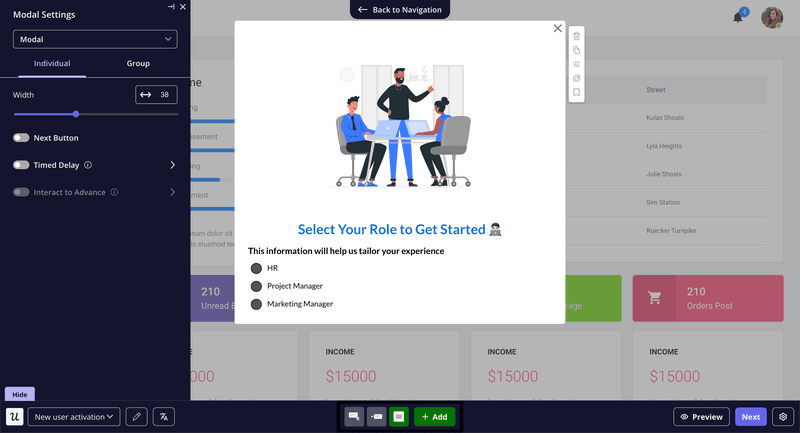
Use interactive walkthroughs to help users realize value
Most users need visual prompts: it’s not enough to just tell them how valuable something is.
Interactive tutorials help lead users to their aha moment. Modals, slideouts, tooltips, and other UI patterns can provide contextually relevant advice that subtly guides users through essential actions.
You could include a progress bar, too, as a handy visual reference that motivates users to keep going.
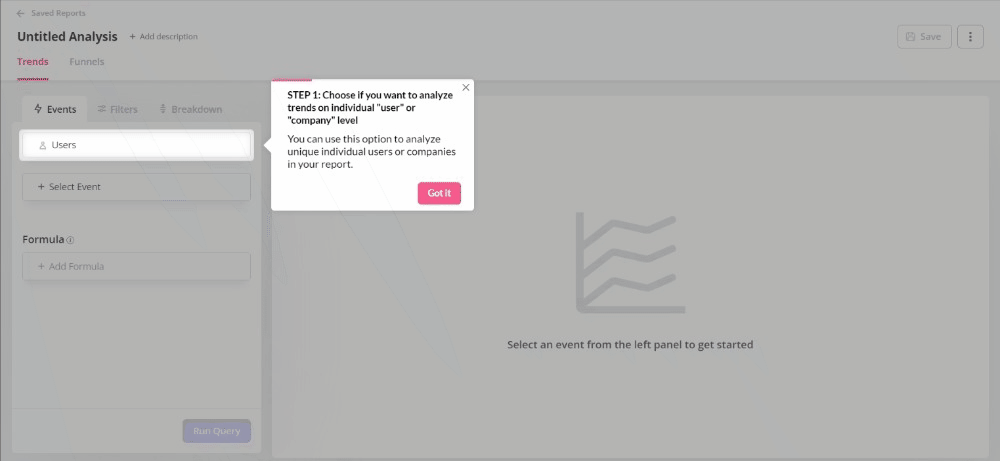
Remove friction from the onboarding process
Savvy product teams look for opportunities to simplify, reduce friction, and cut out unnecessary steps in the user onboarding process. The faster users unlock value, the greater your chances of improving user retention.
After you analyze your current onboarding process with session recordings and analytics, you’ll know which fixes to prioritize in your current product roadmap.
Use gamification to celebrate finding Aha moments
Humans are hardwired to respond to encouragement. It triggers dopamine and positive emotions. So make sure you acknowledge your users’ hard work when they reach their Aha moments.
Visual prompts, positive messages, or badges are all forms of gamification that make reaching the Aha moment memorable.

Trigger contextual in-app messages to engage active customers
Remember, it’s not just about showcasing value in the short term. You need to keep hold of your users. To boost retention, you need to optimize secondary onboarding to make sure you’re engaging active customers with new, relevant features throughout the journey.
Ultimately, the more features on your product roadmap users engage with, the more money you’ll generate through boosting customer lifetime value.

Guide users to their aha moment with Userpilot
Finding your aha moment is a process of discovery. Stop looking at your product as a set of features and start looking at it as a vehicle for user value. The stakes for this early optimization are incredibly high: only 13% of SaaS startups reach $10M ARR after 10 years, largely due to failure in scaling these early activation moments.
By studying these aha moment examples and applying the reverse-engineering framework, you can identify the happy path your power users took. Build the guardrails: checklists, flows, and tooltips to ensure every new user stays on that path, and help active customers find secondary aha moments throughout the whole user lifecycle. The goal is to get them to the point where they can’t imagine working without you.
Ready to start building these experiences? Get started with Userpilot today!

